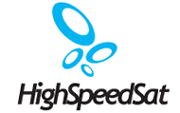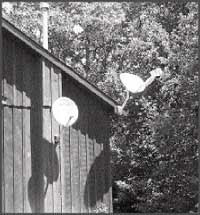
Satellite Internet Connection in Canada
|
Broadband Satellite Internet in CanadaHigh-speed Internet connection via satelliteBy Peter O. Walpole, posted 8/31/2001 1:34:56 PM  I
live in the country. Our access road was finally paved this summer.
For 20 years, I've received TV by satellite dish. I
live in the country. Our access road was finally paved this summer.
For 20 years, I've received TV by satellite dish.On the other hand, I had Internet access before the Web exploded into common knowledge. And yet, even though my modem is rated at 56 Kbps, it rarely connects above 28.8 Kbps. I have definitely not had access to broadband Internet service. According to a recent survey, over 30 per cent of Canadian respondents had no expectation they'd get high-speed Internet access through cable or phone lines. Now there's a solution, although it is extravagantly expensive. It appears that there are some members of the landed gentry in rural Canada who can afford high-speed, two-way satellite connection. C-Com Satellite Systems of Ottawa has implemented a procedure that uses the technology of Hughes Network Systems. The DirecWay system (also known as DirecPC) offers a way to download and upload Internet traffic through a locally mounted dish. DirecWay Starter Kits include outdoor and indoor equipment. Outdoor gear: A parabolic dish, an LNB satellite receiver, and a radio signal return unit. Indoor gear: USB satellite transceiver (ITU), USB satellite receiver (IRU), power supply, USB cable, and an ITU-IRU interconnection cable. First, special software was installed on my computer. I was told I'd need a 200 MHz Pentium processor with 64 MB RAM, some hard drive space, and Windows 98 SE or later. This means most recent PCs will do the job. Access to the transmitter/ receiver is through a dedicated USB port. The system had not been tested through a hub at installation time, so I rearranged my USB connections to free a motherboard port. After the necessary drivers and software had been configured from the installation CD, the job of assembling and mounting the dish began. Professional installation A quick telephone survey of various providers established that DirecWay should work through my Star Choice reception. The Hughes satellite orbits slightly south of Anik, and a bit higher in the sky. While many people have set up TV dishes, the kind of transmission DirecWay dishes receive requires painstakingly accurate calibration and tuning by a professional (it's also much more costly than TV-dish installation). It took the technician putting my DirecWay (HughesNet) dish in place about four hours. With compass in hand, my installer assessed my house and found a suitable spot high on the eaves. The dish and transmitter weigh about 25 kg, so a firm, safe base is essential. Once we were wired in and the transmit settings had been fine-tuned, I had high-speed satellite Internet access to the Web. My regular ISP is still current, along with my e-mail address, but I also received a new account with a "direcpc" suffix. That's standard. My Netscape and Explorer icons default to satellite access, but the modem is still available through C-Com's "My Connection" service. This allows a fall-back if transmission becomes difficult. Both browsers are active and work well. Speed thrills
So, what changes have I seen? I took the opportunity to update
Windows ME. With my old modem, it would take a minimum of 52 minutes
(most probably 90) to download a new version of Media Player. My
first attempt stalled, as the flow of info overloaded my hard drive.
On the second try, the job was over in 63 seconds!
As I write this, a small icon on the "tray" at the bottom
of my screen is indicating that my satellite connection is always
on. A meter suggests I'm getting a signal strength of about 78 (on a
scale between 0 and 100; if signal strength drops below 30, the
system shuts down). |
|||||
|
To
learn more about VoiP over satellite Internet
please click here: |
||||||
